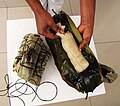Faịlụ:Cassava Bread - cassava cooked in leaf wrap (Kwanga, Chikwangue).jpg

Otu nyochaa a ha:677 × 599 piksels Ndị ọzọ mkpebi:271 × 240 piksels | 542 × 480 piksels | 924 × 818 piksels.
Failụ si na nke mbu (924 × 818 pixel, ívù akwukwo orunótu: 223 KB, MIME nke: image/jpeg)
Ịta nke usòrò
Bìri èhì/ogè k'ị hụ òtù ụ̀fa dị̀ m̀gbè ahụ̀.
| Èhì/Ogè | Mbọ-aka | Ógólógó na asaá | Òjìème | Nkwute | |
|---|---|---|---|---|---|
| dị ùgbu â | 21:45, 17 Septemba 2015 |  | 924 × 818 (223 KB) | Piki-photow | User created page with UploadWizard |
Ojiji faịlụ
Ihe ndị na-eso ihe eji Ihu akwụkwọ eme na faịlụ a:
Ejiji failụ zụrụ ọha
Wikis ndi a edeputara na eji kwa failụ a:
- Ihe eji na en.wikipedia.org
- Ihe eji na en.wiktionary.org
- Ihe eji na es.wikipedia.org
- Ihe eji na fr.wikipedia.org
- Ihe eji na it.wikipedia.org
- Ihe eji na lt.wikipedia.org